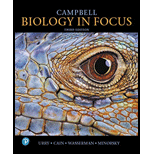
Concept explainers
Extinction vortex is a term used to describe the process which the declining populations undergo when the environmental factors drive them to extinction. The loss of
Answer to Problem 1TYU
The characteristic which distinguishes the population in an extinction vortex from most of the other populations is that its genetic diversity is very low.
Therefore, option C is correct.
Explanation of Solution
Justify the reasons for the correct statement:
The reduced genetic variation decreases the ability of a population to develop in the face of a change. The more genetically diverse population can able to withstand environmental pressures or diseases. But, the less genetically diverse population could not withstand these environmental stresses, thereby making it more likely to become extinct over a given period of time. This characteristic separates the population in an extinction vortex from the other populations.
Option (C) is given as “its genetic diversity is very low”.
Hence, the option (C) is correct.
Justify reasons for the incorrect statements:
Option (A) is given as, “its members are rare, top-level predators”.
The members of rare, top-level predators found to have a large domain of prey for its consumption. This is not a specific characteristic of a population which is drawn into the extinction vortex. Hence, it is the wrong answer.
Option (B) is given as “its effective
The characteristic of having very low effective population size than its total population would not be drained into the extinction vortex. This is the condition unless the effective population is found to be smaller than that of a minimum viable number. Hence, it is the wrong answer.
Option (D) is given as “it is not well adapted to edge conditions”.
Though the populations in an extinction vortex are not well adapted to its edge conditions, this is not a specific property of the populations on the verge of the extinctions. However, there are many other populations that could not able to adapt to the edge conditions. Hence, it is the wrong answer.
Hence, options (A), (B), and (D) are incorrect.
The specific characteristic of the population in an extinction vortex which differentiates it from other populations is provided.
Want to see more full solutions like this?
Chapter 43 Solutions
CAMPBELL BIOLOGY IN FOCUS-W/MASTR.BIO.
 Human Anatomy & Physiology (11th Edition)BiologyISBN:9780134580999Author:Elaine N. Marieb, Katja N. HoehnPublisher:PEARSON
Human Anatomy & Physiology (11th Edition)BiologyISBN:9780134580999Author:Elaine N. Marieb, Katja N. HoehnPublisher:PEARSON Biology 2eBiologyISBN:9781947172517Author:Matthew Douglas, Jung Choi, Mary Ann ClarkPublisher:OpenStax
Biology 2eBiologyISBN:9781947172517Author:Matthew Douglas, Jung Choi, Mary Ann ClarkPublisher:OpenStax Anatomy & PhysiologyBiologyISBN:9781259398629Author:McKinley, Michael P., O'loughlin, Valerie Dean, Bidle, Theresa StouterPublisher:Mcgraw Hill Education,
Anatomy & PhysiologyBiologyISBN:9781259398629Author:McKinley, Michael P., O'loughlin, Valerie Dean, Bidle, Theresa StouterPublisher:Mcgraw Hill Education, Molecular Biology of the Cell (Sixth Edition)BiologyISBN:9780815344322Author:Bruce Alberts, Alexander D. Johnson, Julian Lewis, David Morgan, Martin Raff, Keith Roberts, Peter WalterPublisher:W. W. Norton & Company
Molecular Biology of the Cell (Sixth Edition)BiologyISBN:9780815344322Author:Bruce Alberts, Alexander D. Johnson, Julian Lewis, David Morgan, Martin Raff, Keith Roberts, Peter WalterPublisher:W. W. Norton & Company Laboratory Manual For Human Anatomy & PhysiologyBiologyISBN:9781260159363Author:Martin, Terry R., Prentice-craver, CynthiaPublisher:McGraw-Hill Publishing Co.
Laboratory Manual For Human Anatomy & PhysiologyBiologyISBN:9781260159363Author:Martin, Terry R., Prentice-craver, CynthiaPublisher:McGraw-Hill Publishing Co. Inquiry Into Life (16th Edition)BiologyISBN:9781260231700Author:Sylvia S. Mader, Michael WindelspechtPublisher:McGraw Hill Education
Inquiry Into Life (16th Edition)BiologyISBN:9781260231700Author:Sylvia S. Mader, Michael WindelspechtPublisher:McGraw Hill Education





